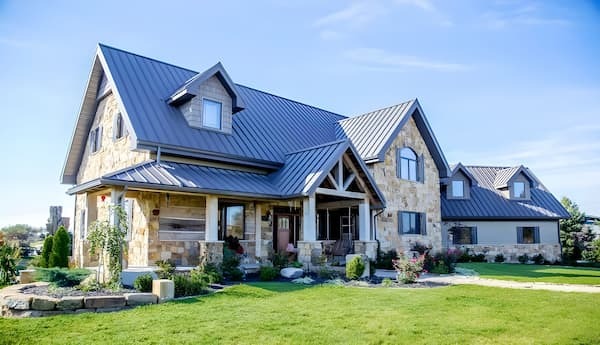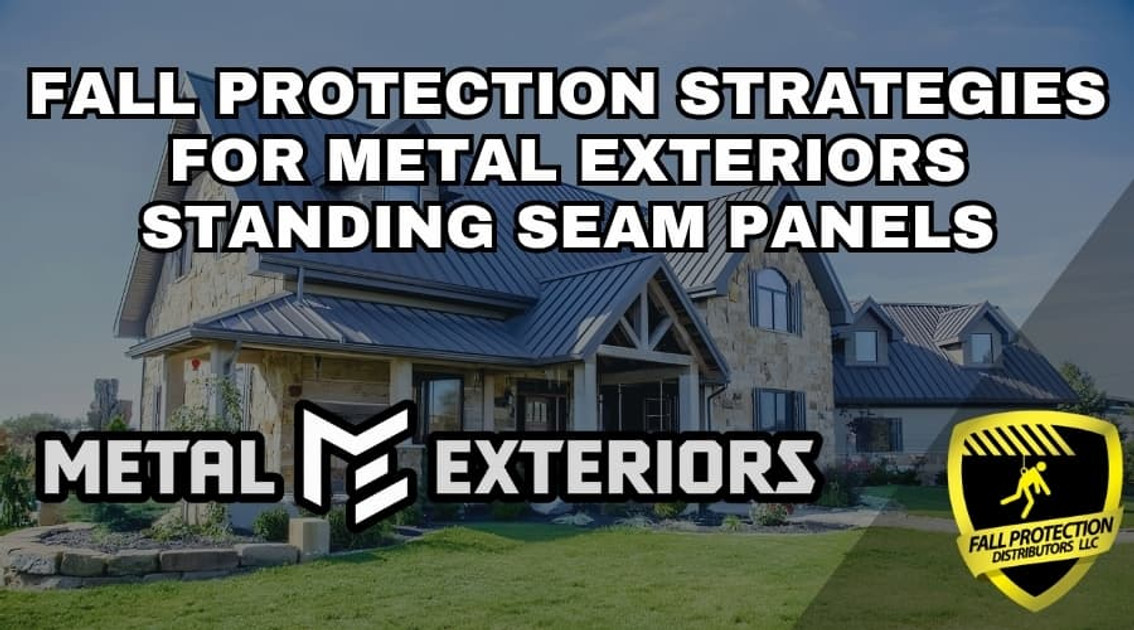Fall Protection For Metal Exteriors Standing Seam Roofs
Posted by Howie Scarboro - CEO Fall Protection Distributors, LLC on Nov 19th 2025

Who Is Metal Exteriors?
Metal Exteriors produces high-quality metal roofing and siding built around family values, hands-on experience, and a commitment to craftsmanship.
Metal Exteriors began in 2013 when brothers Carl and James Zimmerman opened their manufacturing shop in Shiloh, Ohio. Over the years, the company has become a trusted supplier to contractors, homeowners, and agricultural builders seeking durable metal roofing and siding solutions.
The company manufactures an extensive lineup of panels and accessories, supported by a trim shop that produces more than thirty profiles in dozens of standard colors. With modern equipment, consistent quality control, and a customer-focused approach, Metal Exteriors continues to strengthen its presence in the Midwest metal roofing market.

Why Are Compatible Fall Protection Anchors A Requirement for Metal Exteriors Standing Seam Roofs?
Non-penetrating anchors protect the Metal Loc 1.5 seam profile, hidden clip system, and long-term weather-tight performance.
Working safely on standing seam roofs from Metal Exteriors requires fall protection solutions that grip the seam without drilling through the metal. The Metal Loc 1.5 panel relies on concealed clips and thermal expansion to keep the roof weather-tight through seasonal temperature swings. A single fastener in the wrong spot can bind the panel, distort the seam, or introduce water intrusion that remains hidden until damage spreads.
Using non-penetrating anchors solves that problem. These systems attach securely to the seam without penetrations, allowing workers to tie off safely while preserving the roof's structural performance, finish, and manufacturer's warranty. The following sections break down the Metal Loc 1.5 panel and outline the best fall protection anchors, adapters, and lifeline systems to use during installation and maintenance.
Metal Loc 1.5 Snaplock Panel


The Metal Loc 1.5 panel delivers a clean architectural look with concealed fasteners and a 1.5-inch rib that adds strength and visual depth.
Metal Exteriors' Metal Loc 1.5 profile gives builders a dependable snaplock option for residential, agricultural, and light commercial projects. The panel spans 16 inches and has a 1.5-inch seam height. Because this profile uses a hidden clip fastening system, no fasteners penetrate the metal surface, which helps the roof stay weather-tight through seasonal expansion and contraction. The Metal Loc 1.5 is available in various colors and finishes, built on the AkzoNobel paint system, and backed by a limited lifetime warranty.
Contractors can choose between 24-gauge and 26-gauge steel panels. The heavier 24-gauge material is ideal for high-wind areas. The 26-gauge option is a lighter and more economical alternative, making it suitable for residential installations. This system has received recognition from the Department of Energy for its energy-efficient performance, earning the trust of many builders who value its long-lasting protection.
Fall Protection for Metal Loc 1.5 Panels
Steel Metal Loc 1.5 panels require non-penetrating seam anchors on 24-gauge installations, while the lighter 26-gauge version relies on ridge-based tie-off.
For 24-gauge Metal Loc 1.5 panels, crews can work safely using non-penetrating anchors that lock onto the seam without interfering with the hidden clip system. The SSRA1 Standing Seam Roof Anchor tightens onto the seam with 12 stainless-steel set screws instead of through-fasteners, providing workers with a certified tie-off point while preserving the panel's weather-tight performance.
When installers need a stable working platform for trimming, detailing, or material staging, the SSRA2 Roof Jack adapters are an excellent solution. It takes just a couple of minutes for workers to assemble the SSRA2 Adjustable Roof Jack Adapters onto two SSRA1 seam anchors. These adapters support a ten-foot walk board and adjust for both seam height and roof pitch, keeping the board level across steep slopes. This assembly reduces worker fatigue and helps prevent slips on steep metal panels.
Projects that require increased worker mobility across larger roof areas can add SSRA3 Anchor Plates on top of the SSRA1 anchors. These aluminum plates serve as the anchor points for temporary horizontal lifeline systems, including the SSRA HLL 100-Foot Temporary Horizontal Lifeline Kit. That complete kit includes four SSRA1 anchors, two SSRA3 plates, and the Malta Dynamics HLL3001 lifeline, supporting two workers while keeping the entire system non-penetrating.
For 26-gauge Metal Loc 1.5 panels, seam-mounted anchors are not compatible. Instead, workers can use the Ridge Pro Steep Assist Anchor on slopes from 6:12 to 12:12. This ridge-based system hooks over the peak and allows the worker to clip into a vertical lifeline before stepping onto the roof, eliminating seam contact while providing a secure tie-off from the ladder to the ridge and back again.
Using fall protection systems that match the exact seam profile and gauge of the Metal Loc 1.5 panel ensures workers stay safe while protecting the roof's long-term performance. The proper anchors prevent unnecessary damage, maintain warranties, and give crews the confidence to work efficiently at height.
Contact Us for Expert Standing Seam Fall Protection Advice
For expert guidance on standing seam roof anchors, lifeline kits, and fall protection systems that protect both your crew and your panels, contact us today at 863-703-4522 or visit www.StandingSeamRoofAnchor.com. Our safety specialists can help you match the right non-penetrating anchor to your specific roof profile and slope. Let's make your next metal roofing project safe, compliant, and built to last. For continued learning, download OSHA's 48-page Fall Protection Manual and our free Anchor Inspection Form once you've selected the ideal anchors for your roof system. Together, we'll help you stay ahead of OSHA standards while preserving your roof's weather-tight seal.
Metal Roof Safety Tips For Metal Exteriors Standing Seam Roofs
Equip Workers with High-Quality Safety Gear
OSHA fall protection begins with workers wearing gear that fits properly, passes inspection, and suits the job they are performing. Harnesses, connectors, and SRLs should be checked for wear before anyone steps onto the roof.
Use Anchor Systems Built for Standing Seam Roofs
Standing seam roof systems use hidden fasteners to avoid water leaks, so anchor points must connect without penetrations. Non-penetrating anchors, such as the SSRA1, attach directly to approved steel seams using stainless-steel set screws.
Install Permanent Roof Anchor Systems
Routine service access is common in commercial buildings, and OSHA permits permanent fall protection systems when they are installed and inspected correctly. A system such as the Super Anchor 120-foot Permanent Horizontal Lifeline Kit can reduce the need for repeated temporary hardware installation and provide a secure tie-off for future maintenance personnel.
Prioritize Ladder Safety Training
Falls often happen during the climb rather than while working on the roof. Regular ladder training on the correct 4-to-1 angle, three points of contact, and stable ground placement helps prevent access-related injuries. A few minutes of refresher training before setup reduces rushed decisions that lead to preventable accidents.
Develop OSHA-Compliant Safety Plans
A written safety plan clarifies anchor strategy, lifeline placement, rescue procedures, and communication protocols before roof work begins. This planning is required under OSHA guidelines and should account for the panel type, slope, crew size, and selected anchor method.
Encourage the Use of Trauma Straps
Suspension trauma can occur even after a successful fall arrest. Trauma straps allow a suspended worker to relieve pressure and maintain circulation while connected to an SSRA1 anchor or a Ridge Pro ridge-based tie-off. These compact accessories add minimal cost but deliver critical protection until the rescue team takes over.
Set Up Protective Guardrails Near Hazards
Guardrails are among OSHA's preferred fall prevention methods because they physically prevent workers from coming into contact with hazards. When installed near hazardous areas, guardrails complement seam-mounted anchor systems and reduce the need for workers to operate directly beside unprotected edges.
Promote a Culture of Safety
Safety improves when every worker participates rather than relying solely on written rules. Quick daily conversations about hazards, danger areas, anchor setups, and rescue steps help keep the entire team aligned. Crews that communicate openly are more likely to use anchors correctly, maintain tie-offs, and avoid shortcuts.
Ensure Proper Footwear for Stability
Smooth metal panels can become slick from condensation, dust, or early morning temperature changes. Roofing-specific footwear with firm ankle support and excellent traction improves footing on standing seam surfaces, allowing workers to move steadily without hesitation or injury.
Consult Experts for Curved Metal Panels
Curved and tapered standing seam systems create challenges for attaching fall protection anchors. Before selecting any anchor system for these conditions, a fall protection specialist should inspect the roof to determine the best safety strategy to protect the workers.
Disclaimer
The views, recommendations, and information presented in this blog are solely those of the author and do not necessarily reflect the opinions or positions of the featured panel manufacturer, its brands, subsidiaries, or parent companies. Customers are strongly encouraged to contact the roof panel manufacturer directly for inquiries regarding fall protection compatibility with their products and to address any potential warranty issues that may arise after installing our products.

